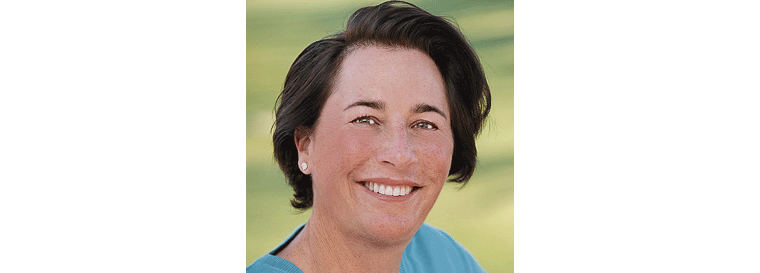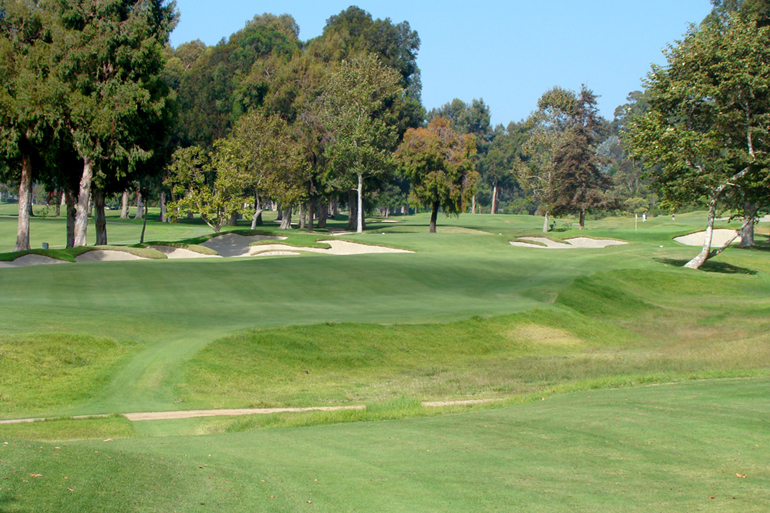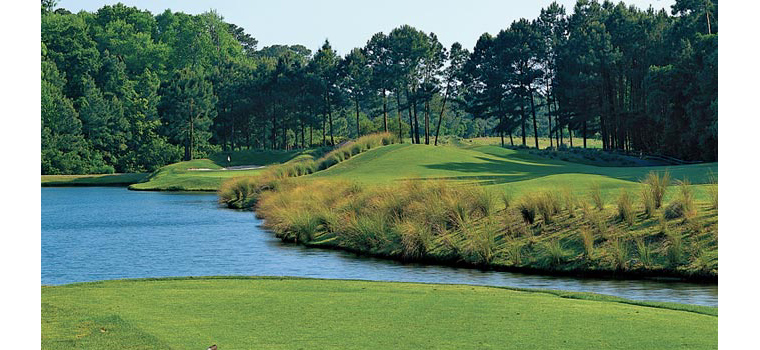Feature Interview with Amy Alcott
February 2013
What prompted you to start sketching golf holes?
I’ve always viewed golf as an art form and I’ve always prided myself as being a shot maker so I appreciate the artistic nature of the game. I approach it with an appreciation and gratitude for the game. I’m always thinking of certain design characteristics as I play but it wasn’t until the latter part of my playing career, maybe the early 1990’s that I started to sketch holes at courses that I liked. I remember certain holes at Manila golf club in the Philippines and Mayfield Country Club in Cleveland as well as unique holes like the 10th at Riviera that I thought would be really fun to integrate them when I had the chance.
I’m a visual person so I enjoy it. Some of these ideas have been incorporated as I pass my ideas as a consultant but since I’m not the co-designer others have not been taken. Some of these would have made the course better but looking down the road I know I’ll have the chance to do it on my own.
You were rookie of the year in 1975. Do you recall the make-up of the fourteen clubs that were in your bag at the time?
I’ve always liked to play clubs I’m comfortable with regardless of affiliation. So when I turned pro I had a very mixed set of golf clubs. In 1975, my rookie year I went to the PGA show and I met this gentleman from Dunlop and I talked about representing them since back then players really didn’t have agents. A few weeks later he sent me a set of Australian blade irons and those are the clubs that I won all my 32 professional events with. I played with those clubs up until the early 1990’s and still have them. They barely have any grooves at this point. Since I was 14 years old I always carried a 7 wood which was unheard of. It was a Power Bilt club and my pro said the only other person he knew who carried one was Lee Trevino. That club was a staple in my bag way before Ginty or hybrid clubs.
What does your set of clubs consist of now?
Now I play a Taylor Made driver and Callaway razor irons starting at a 4 iron. I have an older Cleveland wedge and a 1964 Spalding wedge that I use out of bunkers. I have a 19 degree rescue which is an older club and a hybrid along with a 3 wood and driver. Everything is graphite except for that old 1964 Spalding wedge. I like to read about all of the new clubs but I’m getting to a phase where I don’t update my clubs very often.
How far did you drive the ball in 1975 at age 19? How far did you drive it at age 55?
In 1975 when I turned pro I was in the 235 range and I’m probably still in that range, at least by 5 yards. I was never that long but I was long enough. The key to my game was shot making and the short game. Now I watch the LPGA and its very straight forward, straight swing, down the middle type game. When I won the Kraft – Nabisco championship I had to hit one shot from behind a tree and hook it 35 yards to the green. You don’t see much of that anymore. Some of it is dictated by the ball and the clubs but you need to practice those type of shots and know that you can pull them off. You need to challenge yourself to play those shots. The players today are fine players but don’t necessarily possess the shot making skills. Joanne Carner and Hollis Stacey had great shot making skills. Now it’s all about the straight ball. Bubba Watson hitting the shot at Augusta last year was a real gamer to pull that off and it was fun to see.
You won the 1980 US Open in Nashville at Richland CC, a Ross course that has since been bulldozed for a housing development. What are your recollections of the merits of that course?
The old property was just too valuable and it was bulldozed. They built a new Richland Country Club with Jack Nicklaus as the architect. It was a great golf course with a great variety of holes. It was an old style classic course in very good condition with very fast greens. It played uphill, downhill, left to right, right to left and had a great variety of holes. I enjoyed the playability of it. Even though it was one of the hottest summers in American history, to win the tournament by 9 shots was incredible.
Last year I was watching the players hit balls at Riviera during the Northern Trust tournament. Brandt Snedeker came up to me and asked if I was Amy Alcott. He said that was his home course as a kid and his father still talks about how I won the tournament by 9 shots and how incredible that was. We replayed some of the old holes which was fun.
What are the most common mistakes architects make when building tees/courses for women?
Every architect could do a better job. I don’t think architects build courses for women; you build them for all levels of players. Beginning golfers and senior golfers should be playing the forward tees.
Two summers ago Gil and I made a presentation at Ridgewood Country Club in New Jersey which has a very active women and senior membership. That was somewhat of a mandate, to look at the holes and make them more women and senior friendly. As a result we ended up adding some new tees and they seem very happy with what we created. The course is now playable for all level of players.
You live in Santa Monica and play at Bel-Air and Riviera where Tom Fazio has made modifications at both. What are your thoughts on those changes?
Bel Air is one of my favorite courses and they have done a good job. I love the back nine at Bel Air and the flow of holes; the meandering brook, every hole on the back nine is a great hole. The finishing four holes are very challenging. It’s an original George Thomas design but it’s a canyon course and its much tighter then Riviera. It’s really quite special. It doesn’t have the big sky feel like Riviera and I like that. You have to know where to hit it and maneuver it; the course kind of speaks to you in that way. About the only thing I don’t agree with is the bunker that boarders the green on the left of the par 3 16th far too difficult. It’s too deep and it’s a little farfetched for me. I think it should have a more classic flow to it. The green that needs improvement is the 11th. It’s a postage stamp type green and they need to add some width to it.
Riviera I don’t see a lot of change. The bunker on the right of the 17th green catches more balls and I don’t like the 7th at all with that large bunker. I think they should reshape that. I’m also not a big fan of what they did on the 8th in taking those trees out. It was a much better hole with just one fairway and the eucalyptus trees.
Are you a fan of the work that Gil Hanse and Geoff Shackelford completed on the North Course at Los Angeles CC?
Yes. They opened the course up, maybe just a shade too much for my taste but I really like what they did there. They put a lot more shots around the green which is interesting and something I really like. Probably my favorite thing is the way they upgraded the bunkers. They gave it a complete facelift.
Tell us about your involvement with the Olympic Course in Rio?
The course is basically already designed. Once the course is cleared, I’ll go down and will be involved in the overall design especially the green structures and placement of tees. Gil wants me to be involved in all aspects and is open to hearing any and everything I have to say. I’m also going to be involved in the design of Academy and the practice facilities. We are planning a building with state of the art technology for teaching. The Olympic course will ultimately be a public course left to the people of Rio. The idea is to build it for all levels of players not just for the professionals.
You have partnered with Dan Maples, Clive Clark and Gil Hanse on various projects. Each are very different architects. Name something you have learned from each architect?
There are elements of traditional design that Dan Maples has and I really liked working with him. Clive sees the beauty of things and is a very visual person who isn’t afraid to take chances in design that really work for the good of the golf course. Gil has a traditional element to his design and allows these elements to take hold of the golf course. I played a few of Gil’s courses before I met him and noticed that they don’t favor any particular type of player. Gils courses have a nice flow to them and he doesn’t like the holes to look the same.
You’ve played golf all over the world. What international golf courses have had a significant impact on your vision of golf course architecture?
My short list would be Sunningdale in England which we played on tour, Royal Dornoch in Scotland and Victoria Golf Club in Melbourne.
I’ve traveled to Japan over 40 times and some of those courses have had a very profound impact on me. The courses in Japan have very little land and many of the courses are built on mountainous land and are very hilly. They use every inch of land that was available and the shaping has to be good. Back in the 80’s and 90’s many of the courses had two sets of greens, one being bent grass and the other Kori which is a very spongy grass. I’ve played in nearly every area of Japan and they really have a nice variety of courses in the country.
What should the LPGA do in order to resume a path of growth?
The tour has its challenges but the LPGA players have always been good with their fans and they have been very good with the sponsors. The tour is better after getting involved in Asia over the last few years. American golfers need to have more of an impact and need to come to the forefront. We need more players like Stacey Lewis to challenge this dynamic Korean group. We need some of these young girls to step up their game, polish their game and win more. If American girls made some headlines, American companies will come in as sponsors.
These young players need to embrace their stardom but when it comes down to it you want to be remembered for your game. I wanted to be remembered for my career but everyone is different. There are a lot of different ways to make a living and you can’t fault players like Natalie, Paula or Morgan for marketing themselves. In this day and age it seems like it’s all about marketing yourself.
Is there too much emphasis on pristine conditioning in golf? Has pro tournament conditioning ruined golf for the vast majority of golf courses in the US?
When you look at how European pro players have done over the last few years, these are players that haven’t come from immaculate groomed golf courses and have done quite well. These are players that have learned how to play all types of shots under different conditions and have brought that over here to courses that are groomed for professional golf. They know how to play both the ground game and the air game and have stepped up and contended especially in the Ryder and Solheim Cup competitions. There is nothing prettier than a meticulously groomed golf course, they are beautiful, but I appreciate the imperfect aspects of a golf course which is why it makes it so special. I like both, it’s great to play these meticulously groomed courses but I prefer the firm and fast courses that are imperfect.
Name two golf courses (one classic and one modern) and why that you wish you could say you designed?
Classic, probably Cypress Point or maybe Maidstone.
Modern, I’m sure I’m forgetting some but Long Cove Club is one of my favorites. I started playing it after it first opened after I won a tournament at Moss Creek Plantation which is nearby. Long Cove makes you feel like you’re in several different countries. It’s not just a low country course. It has a Scottish links feel and a California feel as well as the low country feel and then several holes make a big statement. It’s very well done.
I know Alice Dye quite well and she was involved with Pete in the construction of Long Cove. She has her own opinions and the golf industry is lucky to have her.
What’s your favorite U.S. Open venue for women and why?
Of course I liked Richland because I won on it but I loved Oakmont because it was just so damn hard. The greens are just so fast.
Please share with us your thoughts on Pinehurst holding the U.S. Open for men and women on back to back consecutive weeks in 2016.
It’s an innovative idea. It will be bring a lot of business in to that area and it’s worth a try. It will make it easier to operate for the USGA but I’m not sure they completely thought it out because there are a lot of other great courses in that area aside from just No. 2.
I’m not sure how playing Pinehurst with no rough will work? I’m more of a fan of the graduated rough setup for championship tournaments. I like tight fairways with graduated rough and fast greens for majors which reward accurate shot making as opposed to being able to hit it anywhere. You need to stand on the tee and let the course speak to you and say hit me here. If you do so successfully, then you have a shot at the green. If you don’t you’re going to be in trouble. That type of setup tends to bring out the best players.
I do like the aspect of placing the putter into the hands of players from off the green with the closely mowed areas around the greens. Pinehurst and many courses have been going to this and putting the putter in play from 40 yards out. It encourages shot making.
There are numerous all men’s clubs in the world. Could an all-women’s course be successful?
It’s been discussed especially during the Augusta controversy some years ago. I would love to be involved in putting it together a club with women with disposable income that love golf. I’m a little surprised it hasn’t been done, it should be done. I don’t think it should be overly exclusive in not letting men play but maybe just allowing women to be members. Again, in designing such a course, I’m throwing out the old thought process of just designing a course for women; I just want to build a course that’s playable for all levels of golfers.
THE END













